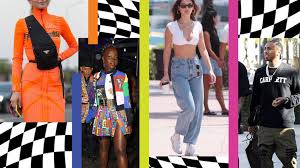Exploring 90s Fashion Trends for Women
The 1990s was a decade known for its eclectic fashion trends that continue to influence style today. From grunge to minimalism, the 90s offered a wide range of options for women looking to express themselves through clothing.
Grunge
One of the most iconic looks of the 90s was grunge fashion. Popularized by bands like Nirvana and Pearl Jam, grunge style featured flannel shirts, ripped jeans, combat boots, and oversized knit sweaters. Women embraced this laid-back and rebellious aesthetic, often pairing plaid shirts with Doc Martens boots for a casual yet edgy look.
Minimalism
On the opposite end of the spectrum was minimalism, a trend characterised by clean lines, neutral colours, and simple silhouettes. Women in the 90s embraced minimalist fashion with slip dresses, tailored blazers, and high-waisted trousers. This understated style exuded sophistication and elegance.
Sporty Chic
The 90s also saw the rise of sporty chic fashion, with women incorporating athletic wear into their everyday outfits. Tracksuits, crop tops, and sneakers became staple pieces in many wardrobes. This trend blurred the lines between activewear and streetwear, creating a comfortable yet stylish look.
Accessorising
Accessories played a key role in 90s fashion for women. Chokers, hoop earrings, bucket hats, and mini backpacks were popular choices that added a touch of flair to any outfit. Hair accessories like butterfly clips and scrunchies were also must-have items for completing the perfect 90s look.
In Conclusion
From grunge to minimalism to sporty chic, 90s fashion offered women a diverse range of styles to choose from. Whether you preferred rocking out in flannel shirts or keeping it sleek in minimalist pieces, there was something for everyone in this iconic decade. Today, we continue to see elements of 90s fashion making a comeback on runways and streets alike, proving that this era’s influence on style is timeless.
Celebrating 90s Fashion: Six Reasons Women Embrace This Iconic Era
- 1. Diverse Styles
- 2. Iconic Trends
- 3. Comfortable Clothing
- 4. Accessory Heaven
- 5. Nostalgic Appeal
- 6. Timeless Influence
Five Drawbacks of 90s Women’s Fashion: From Limited Sizes to Clashing Patterns
- Limited Size Range
- Uncomfortable Fabrics
- Overly Baggy Silhouettes
- Tendency Towards Clashing Patterns
- Lack of Diversity in Representation
1. Diverse Styles
The pro of 90s fashion for women lies in its diverse styles, which offered a wide range of options to choose from, catering to various tastes and preferences. Whether one favoured the grunge aesthetic with its rebellious edge, embraced the minimalist elegance of clean lines and neutral colours, or opted for the sporty chic look blending activewear with streetwear, the 90s had something for everyone. This diversity allowed women to express themselves through clothing in a way that resonated with their individual style and personality, making the era a vibrant and inclusive period for fashion exploration.
2. Iconic Trends
The 90s fashion for women brought forth a plethora of iconic trends that have left a lasting impact on the world of style. From the rebellious allure of grunge to the understated elegance of minimalism and the comfortable yet chic appeal of sporty attire, these trends have transcended time and continue to shape contemporary fashion choices. The 90s era not only embraced these distinctive styles but also paved the way for a new wave of creativity and self-expression in the realm of women’s fashion, solidifying its place as a pivotal period in sartorial history.
3. Comfortable Clothing
Women in the 90s appreciated the pro of comfortable clothing, opting for oversized sweaters, baggy jeans, and sneakers to achieve a relaxed yet stylish appearance. Embracing the trend of comfort in fashion allowed women to feel at ease while still making a statement with their outfits. The combination of loose-fitting garments not only provided a sense of freedom and ease of movement but also contributed to creating effortlessly chic ensembles that resonated with the laid-back vibe of the era.
4. Accessory Heaven
One of the standout pros of 90s fashion for women was the abundance of accessories that transformed outfits into style statements. From the iconic chokers to the playful hoop earrings and practical mini backpacks, the 90s era was truly an “Accessory Heaven.” These trendy embellishments not only added a fun and youthful vibe to ensembles but also allowed women to express their individuality through their choice of accessories. The versatility and creativity that accessories brought to 90s fashion made it easy for women to elevate their looks and showcase their unique personalities with every outfit they wore.
5. Nostalgic Appeal
Embracing 90s fashion allows women to tap into a sense of nostalgia while incorporating retro elements into modern wardrobes. The nostalgic appeal of 90s fashion brings back memories of iconic trends and styles from the past, creating a connection to a simpler time. By integrating pieces inspired by the 90s into their outfits, women can evoke feelings of nostalgia and pay homage to a decade that continues to influence fashion today. This blending of old and new not only adds depth and character to their wardrobes but also allows them to express their individuality through a unique fusion of vintage and contemporary aesthetics.
6. Timeless Influence
The enduring influence of 90s fashion on contemporary style ensures that incorporating elements from this era adds a cool and trendy edge to any outfit. From the resurgence of grunge-inspired looks to the revival of minimalist aesthetics, the 90s continue to inspire designers and fashion enthusiasts alike. Whether it’s a pair of high-waisted jeans, a slip dress, or chunky sneakers, embracing 90s fashion elements allows women to infuse their wardrobe with a touch of nostalgia while staying effortlessly stylish in the present day.
Limited Size Range
During the 90s, one significant con of women’s fashion was the limited size range offered by many brands and designers. This narrow focus often catered to specific body types, leaving a large portion of women feeling excluded and overlooked. The lack of inclusivity in sizing meant that many women struggled to find clothing that fit them well and made them feel confident. This limitation in size options highlighted the need for greater diversity and representation in the fashion industry, emphasising the importance of creating inclusive designs that cater to a wide range of body shapes and sizes.
Uncomfortable Fabrics
During the 90s, one notable con of women’s fashion was the prevalence of uncomfortable fabrics in popular trends. Many iconic styles of that era featured materials that were scratchy, stiff, or simply unpleasant to wear for extended periods. From structured denim to synthetic blends, some garments prioritised aesthetics over comfort, leaving wearers feeling restricted and uneasy throughout the day. This discomfort factor served as a reminder that fashion isn’t just about appearance but should also consider the practicality and wearability of clothing to ensure that individuals feel good while looking stylish.
Overly Baggy Silhouettes
During the 90s, one notable con of women’s fashion was the prevalence of overly baggy silhouettes. The trend towards oversized and loose-fitting clothing could often overshadow a woman’s natural figure, leading to a lack of definition and flattering shapes. While the relaxed and comfortable nature of baggy garments was appealing to many, it occasionally resulted in a style that failed to accentuate the female form in a flattering way. This trend sometimes made it challenging for women to showcase their curves and highlight their best features, detracting from the overall aesthetic appeal of their outfits.
Tendency Towards Clashing Patterns
In the realm of 90s fashion for women, one notable con was the tendency towards clashing patterns. Mixing multiple bold patterns was a prevalent trend during this era, often resulting in outfits that appeared chaotic or overwhelming. While the desire to experiment with different prints and textures was admirable, the lack of cohesion in combining these patterns could sometimes detract from the overall aesthetic. Finding a balance between individuality and harmony in pattern mixing proved to be a challenge for some, highlighting the fine line between bold expression and visual discord in 90s fashion.
Lack of Diversity in Representation
In the realm of 90s fashion for women, a significant drawback was the lack of diversity in representation. Mainstream fashion during this era frequently failed to showcase a wide range of models and influencers from diverse backgrounds. This dearth of inclusivity made it difficult for women of various ethnicities and cultures to feel seen and represented within the industry. The limited portrayal of diversity in 90s fashion perpetuated narrow beauty standards and hindered the celebration of individuality among women worldwide.

